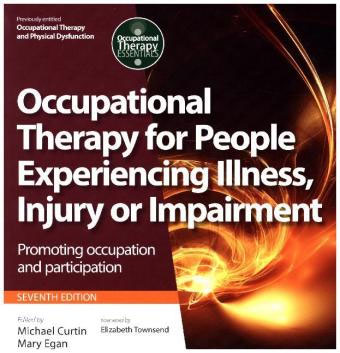Occupational Therapy for People Experiencing Illness, Injury or
Impairment. Promoting occupation and participation.
- ISBN: 9780702054464
- 7th ed. 2017, 840 pages
74,00 €
incl. VAT
plus shipping costs
Depending on the delivery address VAT may vary at checkout.
Delivery time: ca. 1 - 3 days
Description
Edited by Michael Curtin, Jo Adams, Mary Egan.
Part of the series Occupational Therapy Essentials.
Formerly entitled Occupational Therapy and Physical Dysfunction this seminal textbook builds on the strengths of all previous editions and continues to explore the work of occupational therapists with people who are experiencing illness, injury or impairment.
It links theory with day-to-day practice, stimulating reflection on the knowledge, expertise and attitudes that inform practice, and encouraging the development of occupation-focused practice.
The new title, Occupational Therapy for People Experiencing Illness, Injury or Impairment , reflects the knowledge, attitudes and skills that underpin the practice of promoting occupation and participation.
It showcases how occupational therapists work with people – not medical conditions and diagnoses – as individuals, groups, communities, and populations.
The new edition now has additional chapters on the assessment and intervention stages of the professional reasoning process to assist development of enabling skills and strategies.
It also includes many more practice stories throughout to provide authentic examples to illustrate the application of theory to practice.
Learning is further reinforced via access to a new online resource – Evolve Resources – which includes MCQs, reflective questions and three bonus interactive practice stories with accompanying reflective videos.
These are all signposted within the textbook.
Now compromising seven sections, which follow the professional reasoning format of the Canadian Practice Process Framework (CPPF), the new edition first tracks the evolution of occupational therapy in the context of health care.
It then examines the foundational biomedical and social sciences, in addition to occupational science, before going on to the areas of assessment, writing occupation-focused goals, enabling skills and strategies which include advocacy and lobbying, public health, and community-based rehabilitation.
The book ends with a chapter on developing effective reflection skills to enable occupational therapists to critically evaluate their practice, evolve as practitioners, and maintain and develop their professional competencies.
contents:
Preface
Foreword by Elizabeth Townsend
Contributors List
Section 1: Introduction
Chapter 1 – Evolution of occupational therapy within the health care context (Michael Curtin, Jo Adams and Mary Egan)
Section 2: Underpinning sciences
Chapter 2 – Occupational science (Debbie Laliberte Rudman, Rebecca Aldrich)
Chapter 3 – Biomedical sciences (Lesley Collier, Richard Collier)
Chapter 4 – Social sciences (Judith Pettigrew, Katie Robinson)
Section 3: Professional reasoning
Chapter 5 – Client-centredness (Jacquie Ripat)
Chapter 6 – Communication in occupational Therapy practice (Sue Baptiste)
Chapter 7 – Professional reasoning in occupational therapy practice (Carolyn Anne Unsworth)
Chapter 8 – Canadian practice process framework (Noemi Cantin, Martine Brousseau)
Chapter 9 – Occupational therapy practice models (Merrill Turpin)
Chapter 10 – Occupational performance model (Australia): a description of constructs, structure and propositions (Chris Chapparo, Judy L. Ranka, Melissa Therese Nott)
Chapter 11 – The Canadian model of occupational performance and engagement (cmop-e) (Jane A. Davis)
Section 4: Assessment
Chapter 12 – Process of assessment (Clare Hocking, Karen Whalley Hammell)
Chapter 13 – Canadian occupational performance measure (Heather Colquhoun, Anne W. Hunt and Janet F. Murchison)
Chapter 14 – Task, activity and occupational analysis (Cynthia Perlman, Melanie Bergthorson)
Chapter 15 – Dynamic performance analysis (Rose Martini, Dorothy Kessler)
Chapter 16 – Analysis of occupational performance: motor, process and social interaction skills (Gill Chard, Sue Mesa)
Chapter 17 – Perceive, recall, plan and perform (prpp) system of task analysis and intervention (Chris Chapparo, Judy L. Ranka and Melissa Therese Nott)
Chapter 18 – Assessing the environment (Gunilla Carlsson, Agneta Malmgren Ange)
Chapter 19 – Reasoning underpinning assessments for people experiencing neurological conditions (Mary Egan, Lise Zakutney)
Chapter 20 – Reasoning underpinning assessments for people experiencing musculoskeletal conditions (Tanja A. Stamm, Stefanie Haider, Simone Luschin and Agnes Sturma)
Chapter 21 – Reasoning underpinning assessments for people experiencing medical conditions and conditions requiring surgery (Deidre Morgan, Celia Marston and Jenni Bourke)
Section 5: Goals
Chapter 22 – Writing occupation-focused goals (Julia Bowman, Lise Mogensen and Natasha A. Lannin)
Section 6: Enabling skills and strategies
Chapter 23 – Overview of enabling skills and strategies (Michael Curtin)
Chapter 24 – Advocacy and lobbying (Valmae Rose, Kevin Cocks and Lesley Chenoweth)
Chapter 25 – Education (Tammy Hoffmann, Sally Eames)
Chapter 26 – Public health (Rachael Dixey)
Chapter 27 – Community development (Marie Grandisson, Anick Sauvageau)
Chapter 28 – Community-based rehabilitation (Kirsty Thompson, Christina L. Parasyn, Briana Wilson and Beth Sprunt)
Chapter 29 – Coaching (Wendy Pentland, Amy Heinz, Jeanette Isaacs-Young and Jen Gash)
Chapter 30 – Psychosocial support (Jacqueline Mckenna)
Chapter 31 – Working with groups (Claire Craig)
Chapter 32 – Enabling sexuality (Narelle Higson)
Chapter 33 – Personal care (Helen Van Huet, Tracey Elizabeth Parnell and Virginia Mitsch)
Chapter 34 – Leisure (Ruth Squire, Lucia Ramsey and Carolyn Dunford)
Chapter 35 – Work (Yeliz Prior, Alison Hammond)
Chapter 36 – Biomechanical strategies (Hanif Farhan Mohd Rasdi)
Chapter 37 – Hand therapy (Kathy Whalley, Sarah Bradley and Jo Adams)
Chapter 38 – Orthotics
(Natasha A. Lannin, Iona Novak and Michelle Jackman)
Chapter 39 – Working with people living with vision impairment (Alexandra Lonsdale, Carlia Rix and Kirsty Stewart)
Chapter 40 – Optimising motor performance and sensation after brain impairment
(Annie Mccluskey, Natasha A. Lannin, Karl Schurr and Simone Dorsch)
Chapter 41 – Cognitive and perceptual strategies (Carolyn Anne Unswort)
with 200 figs. (80 coloured)
Dr Jo Adams is a Professor of Musculoskeletal Health within Health Sciences, University of Southampton.
Author


